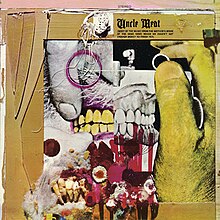Uncle Meat
| Uncle Meat | |||||
|---|---|---|---|---|---|
 |
|||||
| Studio album by The Mothers of Invention | |||||
| Released | April 21, 1969 | ||||
| Recorded | September 1967 – September 1968 at Apostolic Studios, NYC and Sunset Studios, LA | ||||
| Genre | Experimental, jazz, rock | ||||
| Length |
75:43 (LP) 120:44 (CD) |
||||
| Label | Bizarre/Reprise | ||||
| Producer | Frank Zappa | ||||
| Frank Zappa chronology | |||||
|
|||||
| The Mothers of Invention chronology | |||||
|
|||||
| Professional ratings | |
|---|---|
| Review scores | |
| Source | Rating |
| Allmusic | |
| Rolling Stone (1969) | (favorable) |
| Rolling Stone Album Guide (1992) | |
Uncle Meat is the fifth studio album by The Mothers of Invention, released as a double album in 1969. Uncle Meat was originally developed as a part of No Commercial Potential, a project which spawned three other albums sharing a conceptual connection: We're Only in It for the Money, Lumpy Gravy and Cruising with Ruben & the Jets.
The album also served as a soundtrack album to a proposed science fiction film which would not be completed, though a direct-to-video film containing test footage from the project was released by Zappa in 1987. The music is diverse in style, drawing from orchestral, jazz, blues and rock music. Uncle Meat was a commercial success upon release, and has been highly acclaimed for its innovative recording and editing techniques, including experiments in tape speed and overdubbing, and diverse sound.
Frank Zappa, who had been interested in film since high school, decided to develop a film vehicle for the Mothers of Invention, entitled Uncle Meat. The proposed film would combine elements of science fiction and road stories inspired by the band's sexual escapades. Subsequently, Zappa began working on a project called No Commercial Potential, which eventually became the albums We're Only in It for the Money, Lumpy Gravy, Cruising with Ruben & the Jets and Uncle Meat. Zappa stated, "It's all one album. All the material in the albums is organically related and if I had all the master tapes and I could take a razor blade and cut them apart and put it together again in a different order it still would make one piece of music you can listen to. Then I could take that razor blade and cut it apart and reassemble it a different way, and it still would make sense. I could do this twenty ways. The material is definitely related."
...
Wikipedia
